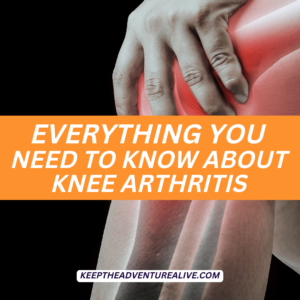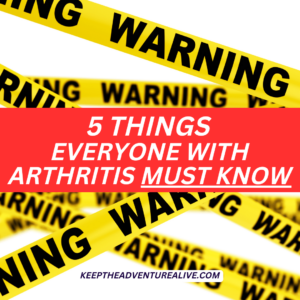If the muscles in the front of your hip are giving you trouble, you could be dealing with hip flexor pain. The hip flexor muscles are responsible for bringing your knee up towards your chest. There can be many reasons why these muscles become irritated including muscle imbalances causing them to overwork, overuse, compensations due to pain such as arthritis pain, and more. Learn 3 exercises to help reduce hip flexor pain in this article below.
Why are my hip flexor muscles so tight?
Tightness in the muscles in the front of your hip can become irritated. It can make it difficult to walk, lift your leg into the car, go up the stairs, lift your leg into bed, etc.
Why does this happen?
Hip flexor pain and tightness could be for a variety of reasons but here are a few common ones:
- compensations due to arthritis pain in the hip, knee, or back
- muscle imbalances and/or weakness leading the hip flexors to overwork
- high volume of walking without supplemental strength program
- rapid increase in walking, running, or stair climbing volume without proper training
- sedentary lifestyle
- spending lots of time sitting
- loss of knee range of motion leading to a change in walking pattern
If you can resonate with any of these reasons above, I want you to know it’s okay! Injuries happen and muscles get irritated.
The key is in what you do to address these muscles and reduce the irritation. Total rest is likely NOT what you need.
As a physical therapist who primarily specializes in helping people not only find pain relief but to unlock adventure with osteoarthritis- hip flexor tightness is a symptom I hear about frequently.
Especially if you have hip arthritis, knee arthritis, and/or degenerative disc disease- hip flexor pain can alter the way you walk. It can make getting into the car and into your bed difficult, and can also make going up the stairs painful.
If you’re experiencing hip flexor pain, there’s one thing to consider first before going into the 3 exercises below.
Address this FIRST!
The hip flexor muscles are responsible for advancing your leg forward when walking.
One of the most irritating activities that can make hip flexor pain worse is walking, especially in high volumes.
Particularly if you have osteoarthritis, one of the main forms of exercise that is recommended is walking by most healthcare professionals.
BUT- this could actually lead to hip flexor pain and tightness if it’s the only exercise you’re doing.
Think about it, as humans we spend our lives primarily moving in one direction- forwards. The muscles in the front of your hip then can become the muscles you use the most.
If you don’t add other movements such as sideways and/or backwards to your routine- your hip flexors can become overworked.
If you are primarily walking for exercise, I highly recommend checking out this article for some ideas on how to add variety to your day. It can be very powerful in providing relief from hip flexor pain.
This is by no means saying you shouldn’t walk. Walking is a great form of exercise. Simply adding in a few other movements to your walking routine can make a world of difference.
3 exercises to reduce hip flexor pain
These exercises can both help to relieve hip flexor pain but also strengthen them to help prevent pain from coming back.
It’s important that these exercises don’t make your pain worse. They should feel good.
If any of these movements do cause significant pain, it may not be the best exercise for you right now. Try reducing the number of repetitions, the range of motion, or the amount of effort you are putting forth to see if pain levels change.
These do progress in difficulty so make sure you master one movement by repeating on at least 3 separate occasions without an increase in significant pain before moving onto the next.
Exercise 1: hip flexor isometric (seated)
This first exercise is one of my favorites as a physical therapist because it can easily be done in a seated position.
Isometrics, meaning you are contracting your muscles without moving can be a great way to elicit pain relief. You are essentially letting your muscle contract then relax, thus ideally becoming less tight.
By contracting the muscle you are bringing blood flow to the area and reducing some of the tension.
You will contract the muscle at about 50% effort as shown in the video below.
Complete anywhere from 5-10 times, holding for up to 10 seconds each time.
Exercise 2: Hip flexor isometric (standing)
This next exercise is a progression from the exercise above. Once you are able to complete at least 10 repetitions on 3 different occasions without an increase in hip flexor pain– you may be able to try this version.
You will essentially be holding a march position at a higher range of motion than in sitting.
This requires more use of the hip flexor muscle which makes it more difficult.
The idea is to hold for 5-10 seconds again without allowing your leg to drop. Please use support for this as balance will be challenged.
Exercise 3: Wall Sit
This last exercise is meant to work all of your leg muscles as once. The goal is to get your leg muscles to work as a team, instead of the hip flexors trying to do everything.
You may not have done a wall sit for a few years or even a few decades but they can be helpful in reducing hip flexor pain.
I like this exercise because you can modify it to your fitness level fairly easily. The further you bend your knees the harder this exercise becomes.
You can just bend them slightly to make the exercise easier.
During this exercise, you want to make sure you are contracting all of your leg muscles from your calf muscles up to your glutes and everything in between.
Hold for up to 30 seconds depending on how difficult it feels for you. Repeat up to 3 times as long as it feels good.
Please make sure not to hold your breath on this one as it can be easy to do when trying to squeeze all of your muscles. Breathe steadily in through your nose and out through your mouth, relaxing your upper body.
Reducing hip flexor pain and tightness
The key to relaxing your hip flexor muscles is to contract them in ways that don’t flare up pain.
These three hip flexor exercises are meant to both contract the muscles and then allow them to relax.
Start conservative with the repetitions as you want to make sure these exercises don’t make pain worse later. It is so important to make sure and monitor how these feel for you both during and after the exercise.
If you experience more hip flexor pain and/or muscle tightness afterwards, it is important to modify accordingly.
Think about reducing your effort back to 50% or below during the isometrics, reducing the range of motion (i.e how deep you are in the wall squat), and/or reducing the amount of repetitions.
It is possible to reduce pain and be able to return to walking normally, climbing stairs and hills with ease, and getting into the car without thinking about it.
The key is being consistent and treating your muscles how they want to be treated. These hip flexor exercises can help get you on the right path.
Find more arthritis tips
If you’d like more exercise tips to reduce muscle tightness, keep your joints healthy, and/or reduce joint pain from arthritis, I have a special opportunity coming for you.
I have a monthly membership coming that will include tips and tricks for reducing joint pain as well as follow along workouts with me, a physical therapist.
To receive updates and be the first to have an opportunity to get inside this membership, make sure you sign up for the weekly email newsletter below ⬇️
Here’s to adventuring!

If you are looking to regain your active life but are unsure where to start, join the revolutionary membership, Adventurers for Life. This is a step-by-step path that not only will help you find pain relief but will help you unlock adventure. You’ll get workouts, tests to pass to make sure you are on the right track, community events and MORE.
Alyssa Kuhn
Disclaimer: This post is for general informational purposes only. It should not be used to self-diagnose and it is not a substitute for a medical exam, cure, treatment, diagnosis, and prescription or recommendation. It does not create a doctor-patient relationship between Dr. Kuhn and you. You should not make any change in your health regimen or diet before first consulting a physician and obtaining a medical exam, diagnosis, and recommendation. Move Well Age Well, LLC and Dr. Alyssa Kuhn, PT, DPT are not liable or responsible for any advice, course of treatment, diagnosis or any conclusions drawn, services or product you obtain through this post, video or site. Complete all exercises at your own risk.




